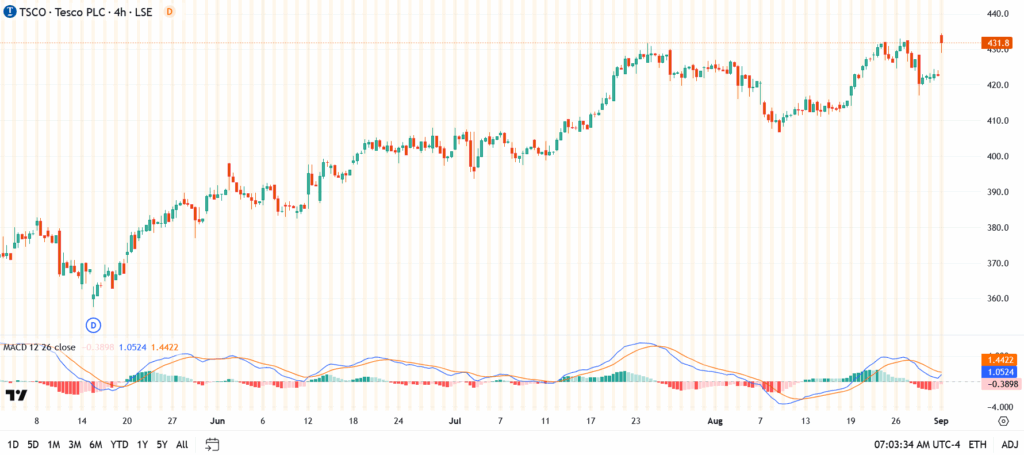Tesco (LSE: TSCO) began Monday trading on a steady note, sitting near 435p, with investors watching closely to see if the stock can build on its late-August strength. The mood has shifted over the past fortnight, gone are the worst fears of an Asda-driven price war, replaced by cautious optimism that Tesco’s dominant position in UK groceries is once again showing through in the charts.
What Is Behind Tesco’s Recovery?
Earlier this year, the narrative was dominated by discounting pressure from Asda, a move that was expected to squeeze margins across the sector. Instead, the numbers show Asda losing ground. Its share of the grocery market has slipped, while Tesco continues to defend close to 28%, a lead that reinforces the idea it can weather competitive storms better than most. For traders who were worried about price cuts eating into profits, that’s a relief.
How Are Analysts Reacting?
J.P. Morgan recently stepped in with an overweight rating and a raised price target of 450p. The note pointed to steadier grocery sales, tighter cost control, and solid customer engagement through Tesco’s loyalty program. While upgrades don’t always shift a stock on their own, this one came at the right time; the market was already leaning bullish, and the call helped push sentiment along. Some fund managers are now asking whether Tesco can stretch toward the 470–480p range if momentum holds.
Tesco Chart Analysis
- Current price: 435p
- Resistance to beat: 450p, with 470p in sight beyond that
- Support base: 420p, then 400p if sellers regain control
- Trend: Higher lows since August; RSI nearing the overbought zone

The picture is balanced. Break above 450p and traders will likely pile in for the next leg. Fail to defend 420p, and the recent optimism could fade just as quickly.
Outlook: What Comes Next for Tesco?
The key question isn’t whether Tesco can survive Asda, that story is fading, but whether it can turn stability into growth. If the company can protect margins and keep loyalty schemes driving traffic, the stock has room to advance. For now, the battle line is clear: 450p is the ceiling investors want to see broken, and how Tesco behaves around that level will set the tone for the weeks ahead.
Tesco’s last earnings run-through was decent on sales, but margins were the sticking point. The company had to absorb heavy price competition, and that trimmed profitability just enough to spook the market. Investors weren’t selling because they doubt Tesco’s dominance; they were reacting to the reality that, in a tight consumer backdrop, every basis point of margin counts.
Plenty of fund managers would argue yes. Tesco still controls nearly a third of the UK grocery market, it pays a dividend, and its scale advantage over smaller rivals remains intact. The long-term case rests on whether management can keep costs in check and fend off the discounters without sacrificing margins. For patient holders, the story hasn’t broken, but the next year will be a test of execution.
The Clubcard has quietly become one of Tesco’s sharpest tools. By tailoring discounts and offers to millions of customers, it keeps shoppers in-house while also building valuable data on buying habits. There has been chatter about fairness in pricing, but from an investor’s standpoint the loyalty program is sticky and it’s working. Expect Tesco to lean even harder on Clubcard as a way to protect market share in a low-growth environment.
This article was originally published on InvestingCube.com. Republishing without permission is prohibited.


